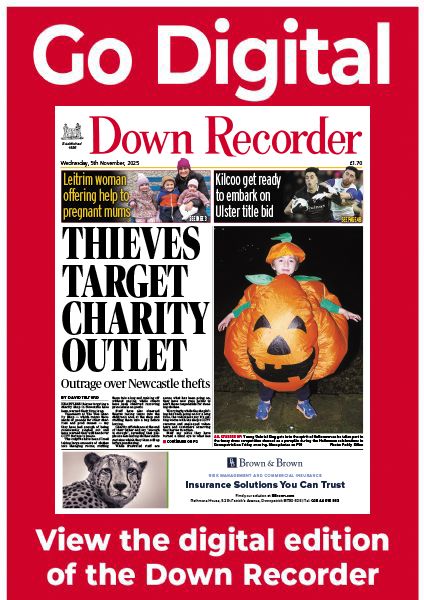Lecale society turning pages of history
Lecale society turning pages of history
22 November 2017
WHAT do the Downshire Hospital, a Downpatrick hotel and the Down Recorder have in common with three emigrant brothers from Lecale, a Downpatrick singing star and the Duke of Wellington?
The answer is that they are contained inside the pages of the latest edition of the Lecale Review, which was launched this week, well in time for Christmas.
The guest speaker at Monday night’s launch was Dr Bob Brown, chairman of the National Trust in Northern Ireland, who commended the society on its continuing role in fostering local history and thanked the contributors for their efforts.
Published annually by the Lecale and Downe Historical Society, the Lecale Review has long been a must for anyone with an interest in local history and this latest offering does not disappoint.
In ‘A Downpatrick Institution’, Colm Rooney looks at the early history of the Downshire Hospital, or, as it was first known, the Down District Lunatic Asylum.
Work began on the imposing building in 1865 and was completed four years later. At times more than 300 workers were on site and were required to work under conditions which would now be considered unacceptable.
The Downshire was declared open on October 8, 1869. On that day 50 men and women came by train from Belfast, but before they arrived the ‘honour’ of being the first patient to be admitted went to a Rossglass man, who was admitted on the warrant to two magistrates.
Denvir’s Hotel in Downpatrick is celebrating its 375th anniversary, which makes it one of the oldest hostelries in the whole of Ireland.
In recognition of the landmark, the Review has republished an article written by the late Dick Oram which first appeared in the Review’s predecessor, Lecale Miscellany, in 1999, with additions from Black Puddings With Slim, written three years earlier by Dr Maurice Hayes, whose family owned and operated the hotel from 1937 to 1984.
A Downpatrick institution, Denvir’s has had many different owners down the years and quite a few famous patrons, including Daniel O’Donnell, the great 19th century Ieader of Irish nationalism, who lunched there while attending Downpatrick Courthouse in his other role as a professional attorney.
The history of another, if slightly younger, Downpatrick institution, the Down Recorder — now in its 181st year of continuous publication — is told by Marcus Crichton, whose family has owned the paper since 1894.
One of the most fascinating articles is Mary Farr’s tribute to Mary Gilmore, the Downpatrick singer who dazzled the opera world. Her talent was discovered at early age by the nuns at her primary school and she went on to principal mezzo-soprano with the celebrated Sadler’s Wells Opera Company in London.
In an obituary published shortly after her death in 1996 she was described as “a truly great artist and a fine human being…unquestionably the greatest talent that Downpatrick has produced.”
The Duke of Weillington finds his way into the Review through his friendship with Lady Georgiana Lennox, who married into the de Ros family which owned Old Court in Strangford.
In an article based on a lecture given to the society earlier this year, Alice Marie Crossland tells of how Lady Georgiana — or Georgy — became firm friends with the ‘Iron Duke’ after meeting him in Dublin as a young girl in 1807.
The friendship continued long after her marriage in 1829 and the arrival or three children. Lady Georgiana lived until she was 96.
Two local estates feature in the Review. Gordon Wheeler and Phllip Blair write about the history of Ballydugan Estate, outside Downpatrick, while Robert Trotter delves into the story of Mount Panther, the elegant mansion between Clough and Dundrum, whose most famous resident was the 18th century diarist, Mrs Delany, and whose most famous guest was a young Princess Margaret.
In ‘Moore of Grangebawn’, William Stranney tells the story of three brothers, George, Samuel and William James Moore, who left their home at Grangewalls, near Killough, in search of a better life in the New World.
Elsewhere, Cecil Lowry recalls his sporting memories in Downpatrick in the 1950s and 1960s, there are some interesting postcards from Dundrum to look at and Richard Clarke reminisces on childhood holidays near Strangford before the start of World War 2.
Lecale Review is priced at £8 and is available from members of the Lecale and Downe Historial Society and selected outlets.


